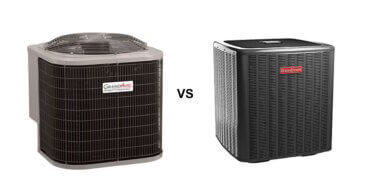If you like the coolness of air touching your skin and calming your hot nerves, you need a fan to pair with your home’s central air conditioning.
When the weather outside gets unbearably hot, a fan puts up a good fight against the heat and keeps things airy.
But one debate we often come across is which fans are better? Are tower fans better or pedestal fans? If you’re thinking of getting a new fan before the hot season arrives and aren’t sure which option to go for, you’ve come to the right place.
This quick guide aims to explain the primary differences between tower fans and pedestal fans so that you can make a smarter decision.
So, let’s dive deeper to know which fan will work better for your place!

Tower Fans Vs Pedestal Fans
Most of us have grown up seeing pedestal fans at our homes, which were mostly nice but sometimes insanely noisy.
Today, if you explore the market, you’ll see sleek-looking fans promising better working, called tower fans. As the name implies, a tower fan has a vertical and slim design, and it doesn’t have rotary fan blades like pedestal fans.
For someone who hasn’t shopped for fans in a while, picking one can be a bit tricky. That’s why we have listed everything you need to understand about these fans before bringing them home. Keep scrolling to know more!
Advantages of Owning a Tower Fan
Besides looking smart, tower fans also promise impressive performance and usability. If you’re skeptical about these fans’ reliability, here are a few factors that might change your mind.
1. Suitable for Compact Places
Tower fans are particularly suitable for compact places, where adjusting a large fan is a hassle. Whether you live in an apartment or need a fan for a small office, a tower fan can be your good friend.
Since tower fans don’t have large blades, they easily adjust in narrow places to provide impressive air quality and speed. You can keep these bladeless fans right in front of you and experience good airflow.
2. Easy Cleaning
You have to dismantle a pedestal fan to clean its blades and motor, which is quite a hectic task.
But things are different with tower fans because of their design. These vertical fans are easy-to-clean because they catch less dust and pet dander, eventually making your cleaning job easier.
You only have to clean dust from a tower fan’s front-facing grill, and that’s all – a bladeless tower fan doesn’t attract dust and reduces your workload alongside.
3. Air Filtering and Purification
Indoor air quality is a rising concern for many homeowners, especially in metro cities and industrial areas.
But thanks to the modern models of fans and purifiers, you can overcome airborne pollutants and their adverse effects. Some tower fans have built-in air purifiers and filters to remove dust, pet dander, and airborne debris to ensure you always inhale clean air.
Related article: How Long Does Pet Dander Stay In a House
Air ionization is helpful for asthma and allergy patients because this method reduces a significant percentage of pollutants. Although the exact purification or filtration feature will depend on the fan design, you can trust tower fans for better performance.
Related article: Best Air Purifiers for Dust Removal and Dust Mites
4. Targeted Airflow
Ceiling and pedestal fans don’t provide targeted airflow, but that’s not a concern with tower fans.
Whether you need a fan to sit beside your office chair or the one that blows air directly on your face, a tower fan will suit you.
A tower fan doesn’t occupy much floor space and blows a nice breeze on the target surface, something we can’t enjoy with bulky fans.
5. Safe for Kids and Pets
If you have little ones at home, they might be tempted to touch a fan’s rotary blades and stop it by hand (let’s be honest, we all have done that), which is risky.
But if you have a table fan with no visible blades, it works as a safer option for kids and pets. Thanks to tower fans’ slim designs, they don’t come in your way and quietly work from a corner.
Disadvantages of Owning a Tower Fan
Nothing is devoid of flaws; tower fans are no exception. If you’re convinced to get a tower fan because of the above-listed points, hold on and see the other side of the picture as well.
1. Small Target Area
If you’re expecting a tower fan to circulate a cool breeze across the room, you might be disappointed because these fans cover a small target area.
Let’s say your tower table fan is sitting beside a sofa and blowing air quite nicely. If you expect this fan to cover a broader area, that won’t be possible.
Tower fans don’t have powerful motors that could cover large areas and rooms. So even if a tower fan works on the highest speed setting, it cannot compete with a pedestal fan.
2. Noisy Performance
Tower fans have entire towers of turbine-shaped blades spinning around inside a cylinder, which means they are noisy.
A tower fan’s basic design might make you think it works quietly, but the noise level coming out of it will say the opposite.
Advantages of A Pedestal Fan
Pedestal fans are the most common type of fans you’ll come across – from offices to homes, these fans work well everywhere.
But is everything good about these fans, or is there something you should be aware of? Here are some points to answer your questions.
1. Powerful Airflow
A pedestal fan’s powerful motor and rotary blades collectively provide excellent RPM (rotations per minute), resulting in a powerful airflow.
If you live in a hot region where a weak airflow won’t suffice, your best bid is a pedestal fan. These fans rotate air at high speed to provide effective cooling ventilation.
If we talk about floor fans for larger spaces, pedestal fans take the lead because they’re built to propel air quite powerfully.
2. Adjustable Airflow
Besides a pedestal fan’s adjustable height, its airflow is also programmable to meet your needs. You can change your pedestal fan’s speed according to the weather and room settings and enjoy its performance.
Although most basic pedestal fans have simple dials for speed adjustment, modern designs also have digital display screens to offer better convenience.
3. Wide Area Coverage
Let’s talk about big rooms where humidity and heat mess everything up.
Even if an air conditioner is on in such a room, you still need powerful and targeted airflow to beat the heat.
That’s when pedestal fans take the lead with their impressive motor power and powerful speed.
One pedestal fan sitting in the corner can circulate air across the room and keep things cool, something we don’t see in tower fans.
4. Better Mobility
You can place a pedestal fan behind the sofa and propel air throughout the room without changing its place.
Pedestal fans’ blades rotate at high speed to ensure you like the results and don’t struggle with the rising temperature.
Since most pedestal fans have adjustable bodies, you don’t need a table or stand to accommodate one – it will be fine on its own.
5. Quiet Working
A pedestal fan’s size might make you think it’s noisy, but it’s not always true. Pedestal fans are very quiet and convenient because of their rotatory mechanism.
Even when a pedestal fan is running at high speed, fan noise won’t disturb you.
However, the key is to pick a high-quality pedestal fan that promises noise-free performance.
You can even use a pedestal fan to create white noise in the room and enjoy deep sleep, all thanks to its silencers.
Disadvantages of A Pedestal Fan
A fair comparison is only possible when you know everything about the target. If you want to decide smartly and want good value for your money, here are some downsides of pedestal fans you should know.
1. Large Footprint
Pedestal pans have big round heads and long stands to offer that unbeatable airflow.
But this design is not always an advantage, especially in compact places. You’ll have to free some space for the pedestal fan’s rotating head and round base to ensure it’s working fine, which is not always feasible.
2. No Advanced Features
Most pedestal fans serve their primary purpose, which is blowing air in a room, and don’t have any additional features for users’ convenience.
If you want a fan that purifies your indoor air and adjusts according to the temperature level, a pedestal fan’s basic design might disappoint you.
3. Aesthetically Odd
If you’re big on aesthetics and don’t want any appliance or device to ruin your sleek interior decor, a pedestal fan won’t sit well with you.
These bulky fans are visible from afar and don’t look sleek, so if you want something discrete, a tower fan is a better choice.
Conclusion: Are Tower Fans Better or Pedestal Fans?
If you cannot compromise on a fan’s speed and airflow, you’re better off with a pedestal fan. These powerful fans propel air at high speed to beat the heat and make a room comfortable in hot weather.
But if you’re inclined towards sleek things and need a modern fan, get a tower fan right away. Tower fans are great for compact places, and their programmable functions offer a better user experience.
Now that we have explained the major differences between tower and pedestal fans, we are sure you’ll decide smartly and love your new fan.
Related article: Fan vs Ac Cost: What Is Cheaper?





Leave a Comment